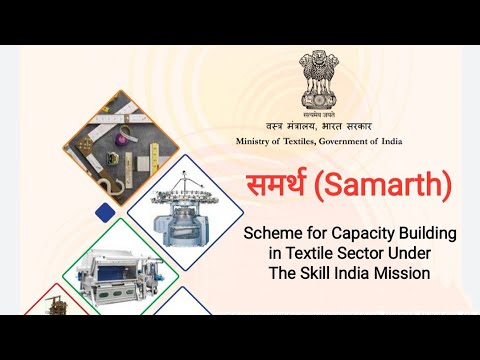Description

Copyright infringement not intended
In News
- The Union Minister of State for Textiles informed the Lok Sabha that the office of the Development Commissioner (Handicrafts) has taken several steps to support textile and handicraft sectors;
- Providing Skill development and training programmes for the benefit of artisans and craftsmen in the handicrafts sector under the skill Development in Handicrafts Sector’ of the National Handicrafts Development Programme (NHDP).
- Implementing the Scheme for Capacity Building in Textile Sector (SAMARTH) to provide skill training to handicraft artisans.
- Under the SAMARTH scheme, more than 13,235 artisans have been trained in the last three years.
Samarth (Scheme for Capacity Building in Textile Sector)
- It is a skill development scheme approved as the Integrated Skill Development Scheme for the 12th FYP (Five Year Plan) by the Cabinet Committee of Economic Affairs.
- The Union Ministry of Textile has launched the Scheme to address the shortage of skilled workers and to provide employment opportunities for unemployed youth who are trained in the sector.
-
.jpg) The main objectives of the scheme are;
The main objectives of the scheme are;
- To provide a demand-driven, placement-oriented skilling programme to incentivize the efforts of the industry in creating jobs in the organized textile and related sectors.
- To promote skilling and skill up-gradation in the traditional sectors.
- To provide sustainable livelihood either by wage or self-employment to all sections of the society across the country.
- It targets to train 10 lakh persons ( 9 lakhs in organised & 1 lakh in traditional sector) over 3 years, with an estimated budget of 1300 crore and has invited the participation of the Textiles Industry/Associations registered under the Central or State Government/Chambers of Commerce of Central or State Government.
- A centralized web-based Management Information System (MIS) was established for better management and implementation such as submission of proposals, the release of funds, enrolment of candidates, functioning of training, physical verification, assessment, placement, post-placement tracking etc.
Indian Textile Sector
- Indian textile industry is the second largest producer of textiles in the world with a massive raw material and textiles manufacturing base.
- China is the largest textile-producing and exporting country in the world.
- The domestic apparel & textile industry in India contributes 5% to the country’s GDP, 7% of industry output in value terms, and 12% of the country’s export earnings. India is the 6th largest exporter of textiles and apparel in the world.
- India is one of the largest producers of cotton and jute in the world. India is also the 2nd largest producer of silk in the world and 95% of the world’s hand-woven fabric comes from India.
- India is the largest consumer and the second-largest producer of cotton with 6 Mn tons of cotton production every year which is about 23% of the world's cotton.
- India is a global leader in jute production, accounting for about 70% of estimated world production.
- The Indian technical textiles segment is estimated at $16 bn, approximately 6% of the global market.
- The Indian technical textiles market was estimated at $17.6 bn in 2020-21 and grew at a CAGR of 10% since 2015-16.
- The textiles and apparel industry in India is the 2nd largest employer in the country providing direct employment to 45 million people and 100 million people in allied industries.
- India has a share of 4% of the global trade in textiles and apparel.
- Average wage rates in India are 50-60% lower than that in developed countries, thus enabling India to benefit from global outsourcing trends in labour-intensive businesses such as garments and home textiles.
- As per the 4th All India Handloom Census 2019-20, there are 35.22 lakh handloom workers across the country.
- The textile sector accounts for 10% of the country’s manufacturing production, 5% of its GDP, and 13% of its export earnings.
Important Steps taken by the Government to support Textile Sectors
- To boost indigenous production and Make in India, Government has increased Basic Customs Duty from 10% to 20% on 501 textile products.
- Amended Technology Up-gradation Fund Scheme (ATUFS) for technology upgradation of the textile industry with a one-time capital subsidy for eligible machinery.
- SAMARTH Scheme for Capacity Building in the Textile Sector (SCBTS) for the entire value chain of the textile sector, excluding Spinning and Weaving in the organized sector.
- National Handloom Development Programme and National Handicrafts Development Programme with the aim of holistic development of handloom and handicrafts clusters through an integrated approach.
- Production Linked Incentive (PLI) Scheme for Textiles.
- To boost exports in the Man-Made Fibre (MMF) sector, the Government has removed anti-dumping duty on PTA (Purified Terephthalic Acid), Viscose Staple Fibre and Acrylic.
- The Government has approved the setting up of Seven Pradhan Mantri Mega Integrated Textile Region and Apparel (PM MITRA) Parks in Greenfield/Brownfield sites.
- These parks will enable the textile industry to become globally competitive, attract large investments and boost employment generation.
- Rebate of State and central Taxes and Levies (RoSCTL) Scheme for Exports of Apparel / Garments and made-ups to make the textile sector competitive in the international market.
- The government has allocated an outlay of Rs.1000 Crores for advanced research and innovation in Technical Textiles at par with the best in the world.
- National Technical Textile Mission for developing usage of technical textiles in various flagship missions, and programmes of the country including strategic sectors.
- Scheme for Integrated Textile Parks (SITP) provides support for the creation of world-class infrastructure facilities for setting up textile units.

Must Read: https://www.iasgyan.in/daily-current-affairs/textile-sector-in-india
https://www.pib.gov.in/PressReleasePage.aspx?PRID=1885413






.jpg) The main objectives of the scheme are;
The main objectives of the scheme are;








